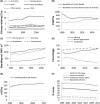Keeping pace with forestry: Multi-scale conservation in a changing production forest matrix
- PMID: 31529355
- PMCID: PMC7067752
- DOI: 10.1007/s13280-019-01248-0
Keeping pace with forestry: Multi-scale conservation in a changing production forest matrix
Erratum in
-
Correction to: Keeping pace with forestry: Multi-scale conservation in a changing production forest matrix.Ambio. 2020 May;49(5):1065-1066. doi: 10.1007/s13280-019-01291-x. Ambio. 2020. PMID: 31734903 Free PMC article.
Abstract
The multi-scale approach to conserving forest biodiversity has been used in Sweden since the 1980s, a period defined by increased reserve area and conservation actions within production forests. However, two thousand forest-associated species remain on Sweden's red-list, and Sweden's 2020 goals for sustainable forests are not being met. We argue that ongoing changes in the production forest matrix require more consideration, and that multi-scale conservation must be adapted to, and integrated with, production forest development. To make this case, we summarize trends in habitat provision by Sweden's protected and production forests, and the variety of ways silviculture can affect biodiversity. We discuss how different forestry trajectories affect the type and extent of conservation approaches needed to secure biodiversity, and suggest leverage points for aiding the adoption of diversified silviculture. Sweden's long-term experience with multi-scale conservation and intensive forestry provides insights for other countries trying to conserve species within production landscapes.
Keywords: Biodiversity conservation; Climate change mitigation; Even-aged forestry; Green-tree retention; Habitat loss; Protected areas.
Figures


References
-
- Andersson E, Keskitalo ECH, Lawrence A. Adaptation to climate change in forestry: A perspective on forest ownership and adaptation responses. Forests. 2017;8:493.
-
- Andersson J, Dynesius M, Hjältén J. Short-term response to stump harvesting by the ground flora in boreal clearcuts. Scandinavian Journal of Forest Research. 2017;32:239–245.
-
- Andersson K, Angelstam P, Elbakidze M, Axelsson R, Degerman E. Green infrastructures and intensive forestry: Need and opportunity for spatial planning in a Swedish rural–urban gradient. Scandinavian Journal of Forest Research. 2013;28:143–165.
-
- Angelstam P, Andersson K, Axelsson R, Elbakidze M, Jonsson B-G, Roberge J-M. Protecting forest areas for biodiversity in Sweden 1991–2010: The policy implementation process and outcomes on the ground. Silva Fennica. 2011;45:1111–1133.
Publication types
MeSH terms
Grants and funding
LinkOut - more resources
Full Text Sources
Miscellaneous

